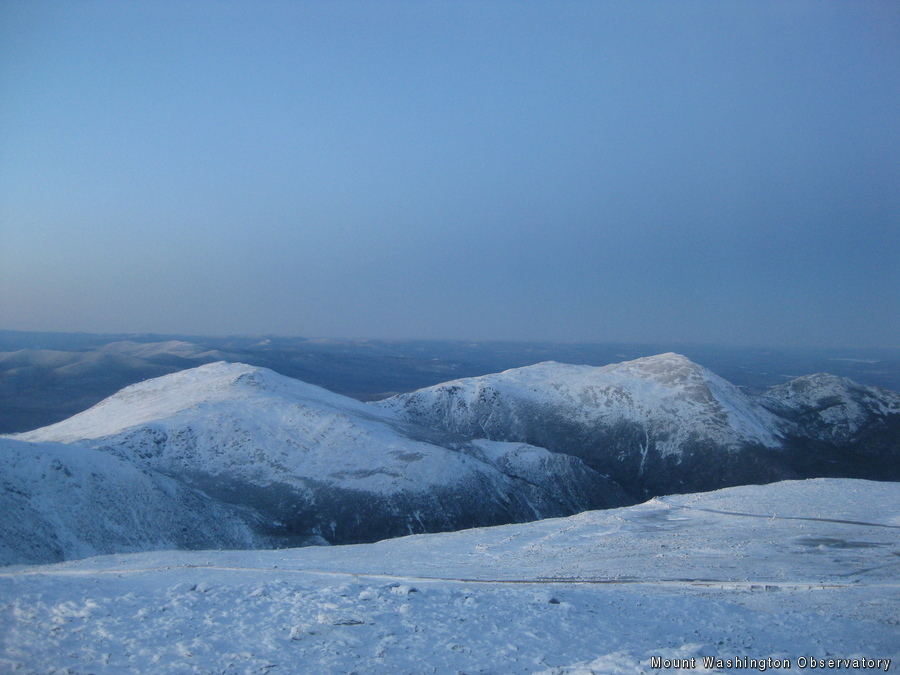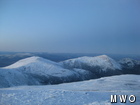The Swamp and The Mountain
2009-12-18 21:35:03.000 – Ryan Knapp, Staff Meteorologist
Crisp and Clear this afternoon.
At the start of one of my college Creative Writing classes we studied a short story that had three characters: a man, a boy, and a swamp. We read three variations of the story but each had roughly the same three elements to it. The reason it sticks out in my mind is how loaded it was with morals depending on which variation we read. And in thinking back to it, I think it is a great story for hikers to keep in mind when hiking up Mt Washington this time of year. Unfortunately I couldn’t find the story online before writing this up, so this is my interpretation of how the “original” story goes:
The Swamp
A hiker (who I will name Joe) sets out on a trail that is known to take three full days to complete. At first, the trail is beautiful, serene, calm and easy going. But by day two, he begins to get lonely and as the trail begins to become difficult and time consuming, he starts to panic that he won’t make it to his pick up point on the third day. So he comes to a swamp and after examining the map he has sees that it will shave a few hours worth of hiking time off his route if he can pass through it. So he pokes and prods the shore along the swamp trying to find a shallow place to cross. Every once in a while he finds what seems to be a suitable crossing but then throws a rock out only to find that it becomes deeper a bit further out. Just as he is beginning to reconsider using this shortcut, he comes across another hiker sitting next to the swamp with water and mud covering his pant legs from the knees down.
Assuming the resting hiker just passed through the swamp Joe runs up to him with much excitement and asks “Does this section have a hard bottom that I can use as a shortcut to the other side?”
The resting hiker answers “Yes, it has a hard bottom, but…” And before the resting hiker could finish Joe begins to walk across the swamp. A short way out, Joe begins to sink past his knees but thinks nothing of it and continues on a bit further. With every step he starts to sink further and further down until he reaches a point where he continues to sink without stopping. He try’s to step back to where he was last standing but can’t find it. Panicking, he tries to swim back to shore but with every movement he seems to be sinking further and further down. So he calms himself and looks back at the man on the shore.
“I thought you said this swamp had a hard bottom to use to cross!,” he yells.
The resting hiker replies “It does. You just haven’t reached it!,” as he throws a climbing rope out to pull the man back to the safety of the shore.
By now, you are probably asking yourself how a story about a man crossing a swamp has anything to do with Mt. Washington in the winter. Well, let me tell it one more time but let me reimagine it a bit to make it more relatable.
The Mountain
A hiker (who I will name Joe) sets out on a trail traversing Mt Washington that is known to take a full day to complete. At first the trail is beautiful, serene, calm and easy going. But by around noon, he begins to get lonely and as the trail begins to become difficult and time consuming, he starts to panic that he won’t make it to his pick up point by the end of the day. So he comes to a point in the trail where he stops and after examining the map he has sees that it will shave a few hours worth of hiking time off his route if he can cross an unmarked section above tree line to a parallel trail down. Unfortunately, a storm has just passed dumping piles of deep snow that is being whipped up and limiting horizontal visibilities a bit. But he decides to try for it. He begins to step a bit off trail but every time begins to sink in waste deep snow. Every once in a while he finds what seems to be a suitable area but and starts to step further out but just sinks. Just as he is beginning to reconsider using this short cut he comes across another hiker sitting next to a cairn with snow covering his pant legs from the knees down.
Assuming the resting hiker just passed through the soft snow Joe runs up to him with much excitement and asks “Does this section have a hard bottom that I can use as a shortcut to the other trail?”
The resting hiker answers “Yes, it has a hard bottom, but…” And before the resting hiker could finish Joe begins to walk the snow field. A short way out, Joe begins to sink past his knees as he post holes around snow covered rocks but thinks nothing of it and continues on a bit further. With every step he starts to sink further and further down until he reaches a point where he continues to sink without stopping and begins to see the snow sloughing off into the glacial cirque nearby. He try’s to step back to where he was last standing but can’t find it. Panicking, he tries to head back to the trail he can barely make out but with every movement he seems to be sinking further and further in. So he calms himself and looks back at the man on the trail.
“I thought you said this section of the snow field had a hard bottom to use to cross!,” he yells.
The resting hiker replies “It does. You just haven’t reached it!,” as he throws a climbing rope out to pull the man back to the safety of the trail.
So what am I hoping you take away from this short story? First, even though it is not relayed in the story, I hope Joe read a forecast online, listened to one on the phone (603-356-2137 ext 1), or read one at a visitor center/hotel in the area. Between our forecast, NWS’s, or a computer generated one by one of several private companies (accuweather.com, wunderground.com, weathertap.com, etc), now and days there is no excuse to say you had no idea what the weather was going to be on the day you are hiking. Second, Joe was hiking alone which some people prefer but this time of year especially, there is safety in numbers. If something goes wrong, the other person(s) can try to help or can at least go for help. Plus it gives you someone to talk to pass the time with. Third, he was right in setting up a time to meet his party at the end of his hike but like so many hikers this time of year; he used an unrealistic hiking time line. The summit might only take 6-10 hours round trip in the summer but in the winter it can be a lot more slow going. Snow, low visibility, more equipment, crampons, etc can all slow you down adding a lot more time. Plus, a lot of people (even some friends I have taken up here) have thought they were a lot more fit than they actually were. This meant a lot more resting breaks which add to the time. If a time line is looking unrealistic, try calling your waiting party (not always the case in the Whites) or consider hiking back to where you started. It is (usually) always safer to head back down from where you came than to head up. The distance to the summit of the mountain is extremely deceiving especially in bad weather. Also, if the way you are going seems unsafe, it is better to turn back to where you started than to get in a worst set up.
Fourth, stick to the trails you set out to take. If you don’t make it to your final destination in the time you wanted, it is easier to mount a rescue searching the trails you set out to do rather than fanning out on the countless trails that traverse the summit above tree line. Plus the cairns provide a visible marker along the path that usually is known to be the safest route. Fifth, always take advice from strangers with a grain of salt. Most advice is dependable but you should always be responsible for yourself and whoever you are with. Remember that the person sharing the information might be as inexperienced as you. I’m not saying that if someone on the trail tells you there is an avalanche danger ahead to ignore them and continue on. But if they say “Oh, the summits only an hour away” and you start experiencing degrading weather and that “hour” is looking like three with no end in sight, it’s safer to consider reaching the summit another day.
I am sure there are other morals and metaphors I can pull from this but four out of the five of these are the ones I wrote about in college: safety in numbers, stick to a realistic time line, avoid shortcuts, and don’t believe everything you hear. It worked well on the first day of class since all of these were applicable to adjust to college life. And with a twist of the story, what can be taken away from the story is applicable to mountain life as well. And with the relatively nice weather expected Saturday, I am sure a bunch of “Joe’s” will be climbing to the summit. As long as these Joe’s don’t act like the Joe in my story, by days end, they will all have their own stories to tell.
Ryan Knapp, Staff Meteorologist
Team Flags Return for Seek the Peak’s 25th Anniversary
Team Flags Return for Seek the Peak's 25th Anniversary By MWOBS Staff Mount Washington Observatory is looking forward to continuing a much-loved tradition for Seek the Peak’s 25th Anniversary: Team flags. In inviting teams
Meet Summer Interns Zakiya, Max and Maddie
Meet Summer Interns Zakiya, Max and Maddie By MWOBS Staff We are excited to welcome six teammates to the summit of Mount Washington this summer! During their internship, these students and graduates will play
Saying Goodbye to the Summit
Saying Goodbye to the Summit By Alexis George After an extraordinary last three years working as a Weather Observer and Meteorologist, I am excited to pursue a different career. As sad I as am






